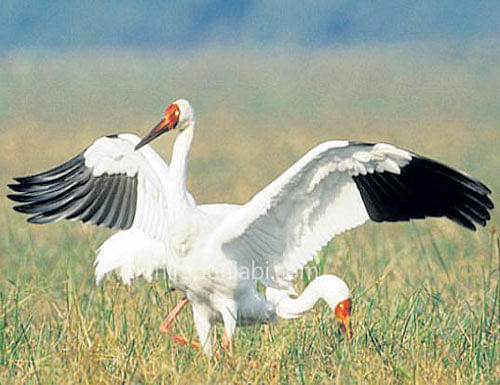
Siberian cranes don’t flock to India during their annual winter migration anymore. Why? It’s because they are extinct. Mrityunjay Bose sheds some light on the reasons behind their disappearance.
The majestic Siberian cranes will never come to India again – it’s almost confirmed now. These birds have not been sighted in Bharatpur National Park of Rajasthan since 2001 and it is very unlikely that they will ever come back to this part of the globe again. It has been 15 years since this bird was last sighted in this part of India.
It’s sad to note that the Indian flock of Siberian cranes is now extinct. The situation looked hopeful a few years ago but ever since the Central population went extinct, the situation seems dire. This plight is in spite of the fact that Keoladeo National Park (formerly known as Bharatpur Bird Sanctuary) is a World Heritage Site, a Ramsar Wetland Site and identified as an Important Bird Area (IBA) by Birdlife International.
No wings to fly
According to the International Crane Foundation, this critically endangered species is now found only in two populations, the Eastern (Siberia to China) and the Western. All but a few existing birds belong to the eastern population, which breed in north-eastern Siberia and spend their winter along the middle Yangtze River in China. The western population winters at a single site along the south coast of the Caspian Sea in Iran and breeds just south of the Ob River east of Ural Mountains in Russia.
A central population of Siberian Cranes that once nested in western Siberia and flocked to India during winters, is no more. The last documented sighting of Siberian Cranes in India during the winter months of 2002. There is a high probability that this population has been recently extirpated.
“The crane population that used to breed in the Ob marshes of Siberia and come to India is sadly extinct. Unless we revive that population and teach them the route of migration to India, it is very difficult to get them back,” says Dr. Asad Rahmani, director, Bombay Natural History Society (BNHS).
But why have these winged beauties stopped visiting us? Is it because of the water crisis in Keoladeo? “It has nothing to do with water shortage in Keoladeo because the decline of the Siberian cranes started much before the artifical water shortage in the park,” explains Asad.
So what is the problem? The answer lies in the migratory route of the birds. The route falls over countries like Russia, Kazakhstan, Uzbekistan, Afghanistan, Pakistan. The birds halt for a short amount of time in the Abi-I-Istada Lake in Afghanistan. “They are hunted in large numbers in this lake. Hence, the numbers reduce every year,” explains Asad.
Even the 2013 International Union for Conservation of Nature (IUCN) Red List of Birds has listed Siberian cranes as a critically endangered species. The traditional migratory and wintering habitats of this species are under constant pressure from the demands of the growing human population. These include: agricultural development, wetland drainage, oil exploration, hunting, and water development projects. The western population is primarily threatened by hunting whereas the eastern population is at risk from loss of wetland habitat, the ICF states.
Dr. Parvish Pandya, associate professor in zoology, Bhavan’s College, recalls his experiences at the Bharatpur Bird Sanctuary. “When I went to the Sanctuary in 1981, I managed to get 18 Siberian cranes in one frame. But looking at the present conditions, I don’t think revival of these pretty birds is possible at all.
Multi-country efforts
Mohammed Dilawar, founder of Nashik-based Nature Forever Society is of the opinion that the war-ridden migratory path of the birds is the main reason behind the decrease in numbers. “This combined with their natural habitat destruction reduced the numbers to a great extent. The revival of this species will need efforts from all the countries. The most important thing to do right now is to secure the migratory path and fund conservatory research. But in current scenarios, this seems bleak,” says Mohammed.
Asad sheds some light on the revival prospects, “It is possible to get semi-wild crane population to Keoladeo. But it demands the government’s attention and dedicated efforts. But sadly, the government is concentrating only on tigers. They think saving tigers will mean saving the ecology. For instance, tigers were exterminated in Sariska and Panna, but they were reintroduced in both the parks. For other species, that will is lacking. In the next 10 years, we will be witness to extinction of many other species in
India, as we are focusing only on glamorous mega-vertebrates like tiger, elephant and rhino. We need to look conserving the entire biodiversity.”
Proving him true are the decreasing numbers of other endangered birds like the great Indian bustards (less than 150) and Bengal floricans (less than 500). “These sad figures portray the lackadaisical attitude of the government towards a complete conservation scheme. Wetlands are being increasingly encroached upon, grasslands are
disappearing, mudflats are being levelled – the list is endless,” concludes Asad.